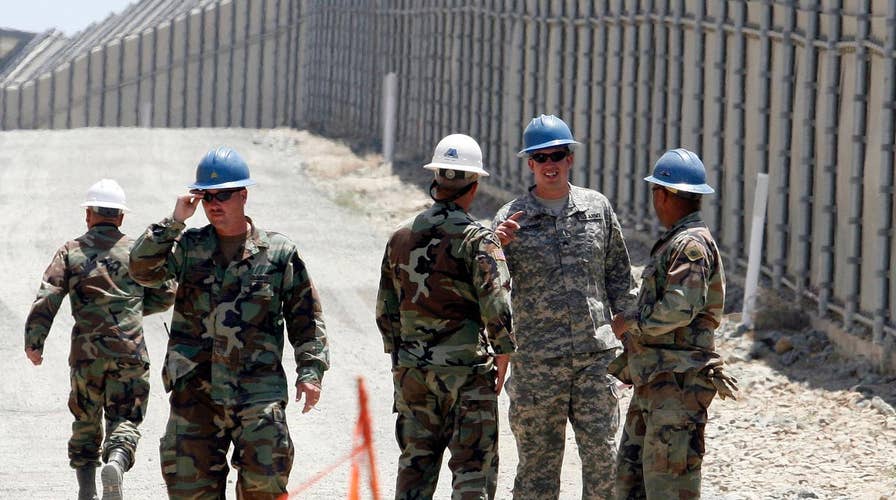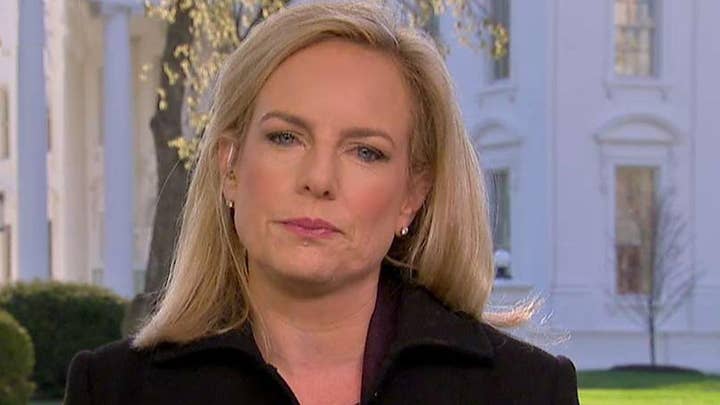Most border-state governors support idea of border troops
Governors of several states have voiced support for President Trump's decision to deploy National Guard troops to the U.S. southern border. William La Jeunesse has insight.
As the nation's governors consider sending their National Guard units to the border, the Border Patrol is being asked what exactly those troops will do.
Sources say you likely won’t see a National Guard soldier standing on the border with an M-16 rifle arresting illegal immigrants. The military is prevented from enforcing domestic law.
What you will likely see is the Air National Guard helicopters providing backup for Border Agents chasing illegal border crossers or checking out sensor hits to determine the number of immigrants having crossed the line.
Guardsmen will also repair vehicles, monitoring and maintaining video surveillance to help provide real-time intel to border agents.
Trump on Wednesday signed a memorandum deploying National Guard. He said Thursday he aimed to send between 2,000 and 4,000 National Guard members to the border.
Critics have called it authoritarian overreach and a militarization of the border. But administration say the step is necessary, as a backup measure, to cut down on the alarming number of people illegally crossing the border.
“The urgency cannot, however, be underscored,” said Kirstjen Nielsen, Secretary of Homeland Security. “We will be doing this today, under the president's direction. I will continue my conversation with all four border governors, and we hope to have the path forward very much specified in the near future.”
Apprehensions at the border have fallen during the past 20 years as Mexico’s economy has improved. But during the past 12 months, arrests have increased dramatically – from 16,000 to over 50,000, most notably in South Texas, where apprehensions are three times higher than the next busiest sector.
That could be the first place to see the National Guard.
The guard already helps in drug interdiction. But the latest call-up will ramp up their presence on the border. The logistics – the number of federal troops, where they will be and how they will integrate with border patrol agents – is still being worked out.
One congressional aide said that lawmakers anticipate 300 to 1,200 troops will be deployed and that the cost was expected to be at least $60 million to $120 million a year. The Pentagon would probably need authorization from Congress for any funding beyond a few months, said the aide, who wasn't authorized to speak publicly and spoke on condition of anonymity.
Under the mechanism the administration is looking to use, the Guard would not be mobilized as a federal force. Instead, governors would control the Guard within their states.

The Guard already helps in drug interdiction. But the latest call-up will ramp up their presence on the border. The logistics – the number of federal troops, where they will be and how they will integrate with border patrol agents – is still being worked out. (Copyright 2017 The Associated Press. All rights reserved.)
Governors of the four U.S. states bordering Mexico were largely supportive of the move. The office of California Gov. Jerry Brown, a Democrat who has sparred with Trump on immigration issues, said any federal request would be promptly reviewed to determine how the state could best offer its assistance.
The Mexican foreign ministry said Nielsen told Mexico's top diplomat that troops deployed to the border "will not carry arms or carry out migration or customs control activities."
There have been two previous guard call-ups, one in 2006 and the other in 2011. But experts say a lot has changed since the last one.

Apprehensions at the border have fallen during the past 20 years as Mexico’s economy has improved. But during the past 12 months, arrests have increased dramatically – from 16,000 to over 50,000, most notably in South Texas, where apprehensions are three times higher than the next busiest sector.
Half of those apprehended at the border are Central Americans, not Mexicans. A senior border agent told Fox News that poses a big problem.
Mexicans can be immediately sent back to their home country. But the process to deport Central American, many of whom claim political asylum, is more complicated. Many end up through the immigration court system, which has been saddled by a massive backlog.
Nielsen said the administration is talking to the governors of the four border states and figuring out how to best use the troops at the border.
“The idea here,” she said, is to choose the different missions sets that the different National Guard can perform to help our border patrol.”
The Associated Press contributed to this report.























